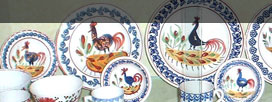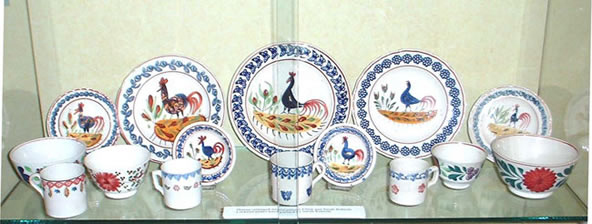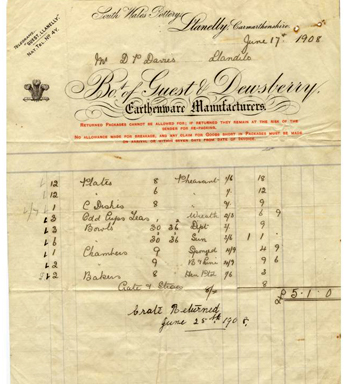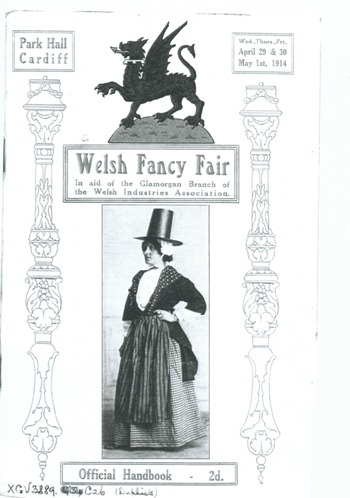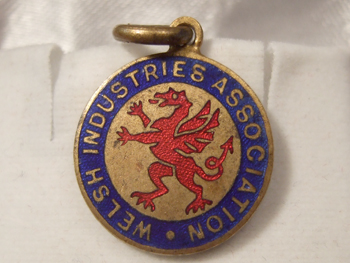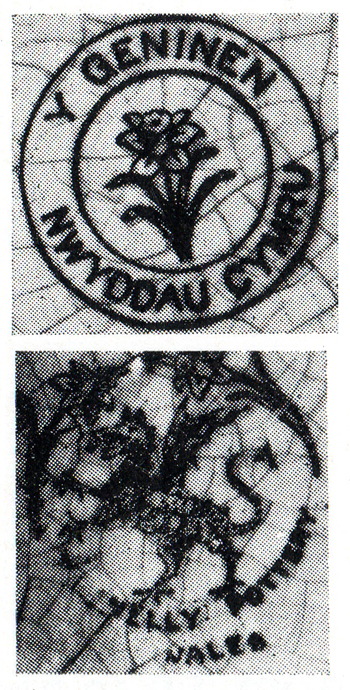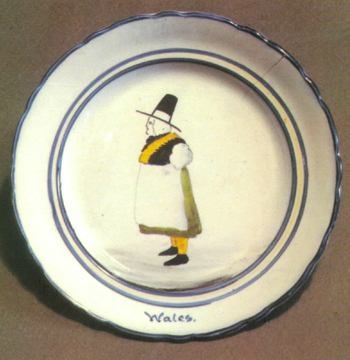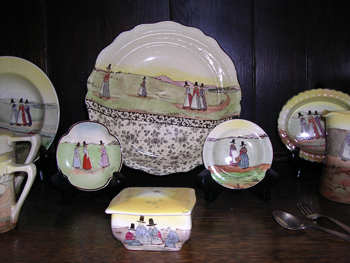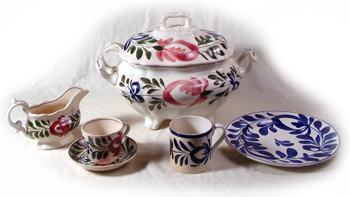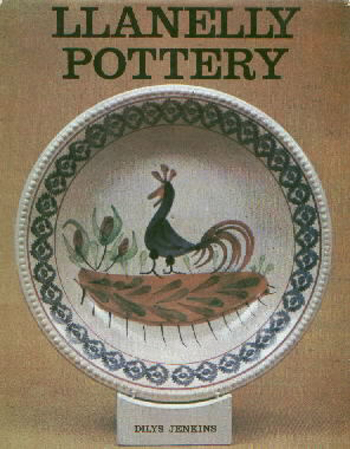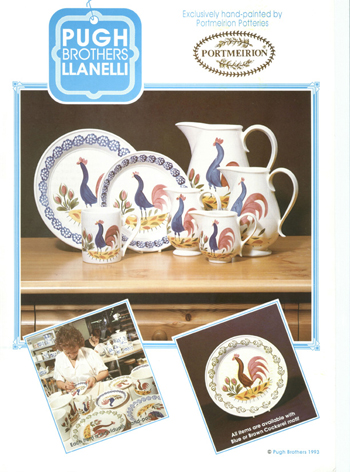Interpreting Ceramics | issue 13 | 2011 Articles & Reviews |
|
|||||||||||
Llanelly Pottery – A Welsh Metonym – continuedKathy Talbot |
|
|||||||||||
|
The volume of hand-painted ware from the Pottery indicates that other local people, probably women, were recruited to work in the painting shop but it is the plates, bowls and jugs with the cockerel motif believed to be by Sarah Roberts that are most sought after by collectors and valued as family heirlooms.
Sarah Jane Roberts, through stories in the books by Jenkins and Hughes and Pugh, became the fabled paintress at the Pottery. The identity and personality of ‘Aunt Sal’ was characterized by the familiarity of address, her claimed relationship with children visiting the Pottery and her hard work, as historically it was written that she had painted all the cockerel plates. Despite the poor quality of the pottery body, the plates have survived in reasonable numbers and it was thought that the claim of her being the sole decorator was impossible and therefore that other decorators were also working on this popular line. However, when in 1993 the Llanelli firm, Pugh Brothers, commissioned a hand-painted plate from a Staffordshire pottery to commemorate their centenary, it was observed that each hand-painter could decorate in excess of twelve in an hour, with an identical style of motif and therefore Sarah Roberts’s sole authorship may have been possible.21 ‘Aunt Sal’ epitomized a strong work ethic and the deep-seated family ties that continue to exist in the South Wales area and are part of the Welsh notion of identity and hiraeth; a ‘peculiarly Celtic form of nostalgia’22 which describes a longing for Welsh land and language, for a spiritual home. Sarah Roberts became established as a mythic character in later literature23, which enhanced the later value of the plates believed to be decorated by her. Where the decorative motifs could be ascribed to either Samuel Shufflebotham or Sarah Roberts at Llanelly the values were higher than for other Llanelly decorated pottery once a collector’s market started in about 1970. The justification for this price differential for Shufflebotham’s work cannot be any superior reputation or quality of Llanelly Pottery over Pountneys, and therefore must lie with the identification with Llanelli. The Value of Llanelly Pottery – cultural or economic The Pottery was manufacturing for a local low price market. It was competing with the wares from Staffordshire being sold and actively advertised by the local china dealers. None of their newspaper advertisements in the first years of the twentieth century mentioned the local pottery and it would appear to have largely been sold at bazaars and fairs. There was little cultural capital to be gained or displayed through ownership, although the knowledge that Lady Howard Stepney had purchased some plaques may have influenced purchases for the aspirational classes. The monetary value of Llanelly Pottery and particularly the cockerel plates has escalated in the some one hundred years since they were first produced. While pecuniary value is not, of itself, an arbiter of significance to individuals or society, it is an indicator of the social and cultural value. A chronological investigation demonstrates the change in monetary values, which can be linked to cultural and social influences. Information on the initial prices of the Llanelly ware including the cockerel plates is largely oral, as the Pottery records and sales books have not survived. As much of its wares were sold through markets and fairs there is little opportunity to trace retail prices, except that Lady Stepney is believed to have paid 2s 11d each for her plaques.24 One invoice has been found which lists a range of goods being sold wholesale to a retailer, D.P. Davies, in Llandeilo (some 10 miles from Llanelli).
The prices are comparable with the ones quoted for Cardiff china retailers in the Pottery Gazette in 1910.25 The bakers, large oven dishes, at 1s 6d for 8 cost twopence farthing each, wholesale. At a few pence in the early 1900s these utility and decorative items would have been affordable by the majority. Contemporary with the invoice is a known purchase of a cockerel plate in Llanelli. The widow of a Swansea doctor recollected that in about 1910 her husband’s ‘Nan’ (grandmother) had purchased a cockerel plate for him in Llanelli market for ‘a few pence …twopence’ (less than 1p). When the plate was later smashed into several pieces during a house move, it was very expensively restored, demonstrating its value to the family.26 The everyday nature of the ware, including the cockerel plates, and its low cost in the early 1900s, are evident in conversations with older residents of Llanelli. Mrs. Muriel Williams said in her interview with Gareth Hughes that in her family home they had some candle sticks and a plaque painted by Shufflebotham, but none of the other ware; they ‘didn’t fancy them’ and ‘regarded them as rather cheap ware’, preferring the imported Staffordshire pottery and endorsing E. Morton Nance, Dilys Jenkins27 and later views of it not being the ‘best crockery’.28 Mrs. Sinclair, the great niece of the paintress Sarah Roberts, even recalled that the cockerel plates ‘were used for mixing paint’ in the family’s market garden and florist business in Llanelli in the early twentieth century.29 A hundred years later the plates are much sought after. As Pearce observed, the value placed on objects can vary considerably over their life: ‘despised rubbish becomes first collectable and finally a major acquisition.’.30 Welsh Industries Association – Influence on Welsh identity and design of motifs in Welsh pottery
The Welsh Industries Association (WIA) was established in March 1898.31 It was largely concerned to revive textile production in Wales with a view to relieving rural poverty, but it also dealt in wares of two potteries, Llanelly Pottery and Ewenny Pottery near Bridgend, but it does not appear to have been concerned with the identity of individual decorators. The philanthropic actions of upper-class women, in supporting and encouraging the expansion of rural trades, were part of the structure of Victorian society, where both altruistic intention and social aspiration could be combined. Despite its title, the WIA Executive committee was based in London, and meetings were held at the London homes of the upper-class women who were committee members.32 Committees made up of local gentry and upper class women were formed for each Welsh county and held fairs and bazaars, selling bric-a-brac, to raise funds throughout the various counties. (Fig 6). Depots were established throughout Wales to take in Welsh manufactured goods, which were then sent to London for sale. The WIA’s commitment to a Welsh identity was often more determined than the industries it promoted. As early as 1899 the Executive committee decided that all circulars should be translated into Welsh and all members were given badges in the design of a red dragon.
Llanelly Pottery did not focus on its Welsh location and identity as a selling point, and its wares fitted well within the broader market for English ceramics. However, the WIA was active in promoting Welsh origin and identity. In December 1907 the London committee rejected some Llanelly wares. The minutes note that ‘all lustre goods marked “England”’ were returned to Llanelly Pottery. The WIA was keen to demonstrate, to those buying from the London depot, the Welsh origin of the goods whereas the Pottery, probably as part of its everyday practice, was falsely indicating place of manufacture as England. Not only may this false indication as to place of manufacture have persuaded locals to buy the goods, but it also enhanced marketing potential in England. Following the rejection in 1907 of items marked ‘England’, in 1911 the minutes of the London Depot of the WIA recorded:
The extent to which the Pottery accepted the WIA’s proposal appears limited. Hughes and Pugh note that there are very few examples of the marks showing a Welsh origin which they describe as ‘Y Genhinen Arwydd Cymru’.33 Jenkins’s book shows two rare marks, a printed mark ‘Y Geninen Nwyddau Cymru’and apainted mark of a dragon and daffodils with ‘Llanelly Pottery Wales’ underneath.34 The dragon motif is very similar to that depicted on the WIA badge. (Fig 7 and 8)
This issue of back-stamps on the pottery shows the dichotomy between the object of the WIA to promote Welsh products, and a ‘naïve’, Welsh folk identity, and the Pottery’s own objective to sell its goods to its known markets locally as well as north Devon and also to the United States of America, where ‘Wales’ would not have necessarily been recognised. The Pottery was intimating that they were from England, probably Staffordshire, and thus disassociated from the negative perception of ‘cheap stuff’ referred to by Mrs. Williams in her conversation with Gareth Hughes. The recorded marks on Llanelly Pottery do not include ‘England’ but, in view of the similarity of shapes and finishes used across the industry, any items found so marked may have been attributed to Staffordshire factories when they had in fact been made in Llanelly. The issue of Welsh identity in pottery production recurred in 1914. On 23rd April 1914 the WIA London Depot minuted the following:
The outbreak of World War I in August 1914 changed the focus of the WIA to supporting the war effort with textiles and knitted goods for the troops and pottery was no longer mentioned. This attempt by the WIA to make distinctly ‘Welsh’ items may have had some impact on the Pottery. A few items with a figure in Welsh costume were produced. A plate in the museum at Carmarthen has ‘Wales’ written on the rim. (Fig 9) Another identical example has the wording ‘Welsh costumes’.36 Although the WIA was keen to sell a ‘Welsh’ identity to a broader British public it would appear that the local pottery saw little local, Welsh commercial opportunity in using ‘Welsh ladies’ or the faux, traditional Welsh dress as decorative motifs.
The traditional image of women in Welsh costume can be found on Staffordshire pottery and was also included amongst Doulton’s ‘Series Ware’, introduced about 1905. It was included under the heading of ‘Rural England’, demonstrating the ambiguity in the understanding of a distinct Welsh identity.
These items were offered to visitors to Wales as tourist souvenirs, which Llanelly may have sought to penetrate with picturesque, naïve motifs of boats and rural cottages, copied directly, possibly under Shufflebotham’s direction, from the Dorset potteries. However, they do not appear to have expanded the production of items with Welsh costume. A revival of identity Following the closure of the Pottery in 1922, Lady Howard Stepney started to retrieve some of the work’s artefacts and wares. A list of items offered to her in 1938 indicates a rise in price levels.37 At that time, 66 items were offered for £15 0s 6d. In comparison with the 1908 invoice (Fig 5), when a transfer printed ‘Pheasant’ plate was priced at 1s 6d for 8 (7.5p for 8 or less than 1p each) wholesale, by 1938 its ‘retail’ or collector’s value was 5s 0d (25p). A cockerel plate was also sold to her for 5s 0d.38 The veneration of the cockerel plates was not to come until later and the particular interest of Lady Stepney, a wealthy member of the local gentry, may have inflated the prices at which these items were sold to her. As the century progressed however, the market widened and there was a growing popular taste for the cockerel plates and a later modern facsimile. Their naïve style proved more popular than the contemporaneous naturalistic work by Shufflebotham. The taste for the cockerel plates had a particular local resonance with Llanelli, but the lively design of the cockerel motif could also appeal to the wider taste for folk style and naïve decoration. The cockerel plates may also have had wider aesthetic appeal as their naïve character fitted with the appeal of a rural life, self-sufficiency and revived interest in handcrafts during the 1970s, following the hedonism of the ‘Swinging Sixties’.39 E. Morton Nance brought Llanelly Pottery to the collectors’ attention when he made reference to it in his seminal work on Swansea and Nantgarw pottery and porcelain, first published in 1942. He indicated Llanelly was not worthy of the reputation accorded to Swansea and Nantgarw, being ‘…unpretentious and for domestic use, busts, vases and other ornamental articles … at least equal to the average Staffordshire pottery of the period’.40 However, had he succeeded in writing further on the subject his authority may have raised its profile and value to collectors in the 1940s. It was not until 1968 that the first slim volume devoted to Llanelly Pottery was written by Dilys Jenkins. This coincided with, or possibly created, a market for Llanelly Pottery as collectable. The nature of the pottery was consistently viewed as being of lower quality. Jenkins summed up the comments of Llewellyn Jewitt from 1894 and Nance from 1942 when she wrote in 1968 that ‘the ware produced by the South Wales Pottery was strictly for every day use’. It had ‘honest workmanlike shapes and unpretentious colours of common earthenware. Their lack of quality is, somehow, very human’.41
It is evident from these descriptions and when looking at the collections that the earthenware pottery was in general not distinctive nor of fine quality. However, the reintroduction of hand painting and the identification of two particular decorators led to the ware being both valued on an individual basis and achieving high prices among collectors. In the 1960s a Llanelly cockerel plate could still be bought from second-hand stalls in Carmarthen Market for ‘a few shillings’. Jenkins observed in 1968, on the inside jacket to her book, that ‘prices have, generally, lagged behind those of better known factories’. However, soon after her book was published, prices began to increase and Llanelly items appeared in local antique auction catalogues in the 1970s. The first two cockerel plates offered at auction in the 1970s were sold for £12.00 for the pair.42 The popularity of the cockerel plates developed from the 1970s. It may have been influenced by the publication of Jenkins’s book coupled with a renewed interest in a Welsh, and particularly Llanelli, character.
The third quarter of the twentieth century was a period that strengthened both Welsh identity and Llanelli identity. Election of a Plaid Cyrmu MP was followed by the investiture of the Prince of Wales. Social solidarity developed as cut-backs occurred in the traditional heavy industries and Llanelli’s success in rugby against the New Zealand All Blacks became legendary.43 There is no direct evidence that these events influenced the increase in values achieved for Llanelly Pottery but there was heightened awareness. With few other locally identifiable decorative products, the pottery from the early twentieth century was a focus for the emotive forces of nostalgia and identity. The values achieved for cockerel plates at auction continued to increase throughout the twentieth century and reached in excess of £600.44 Uniquely in October 1999 a 12 inch cockerel plate was sold at the auctioneers Sotheby’s ‘Welsh Sale’ and reached £1035 (Lot 454, A Llanelly Pottery circular dish). It was described as ‘probably painted by Sarah Roberts’. The price achieved was driven by bidders determined to acquire the plate with the decorator’s attribution. However there was also the personal prestige of having purchased the item at an auction run by high-profile, high-status London auctioneers. The prices gained at auction, a ‘tournament of value’,45 are a consequence of the competition between one person’s emotions and those of others. The desire to outbid others can be the result of subjective sentiment and monetary value need not reflect aesthetic worth or rarity, but can be an indicator, or sign, of cultural and social significance, and this is demonstrated in the prices achieved for items decorated by Sarah Roberts. Both buyers and objects for sale are displaced from their usual context and the bidders come together as a ‘community’, briefly sharing a common identity, with the shared objective to buy while at the same time being contestants. Although catalogues include a ‘guide price’, the value of the object and the price achieved are dependent on the attendees and their individual agenda. Personal desire to acquire an object, or deny another person the object, can increase the auction price in excess of what would normally have been expected. Local or personal association or the need to complete an existing collection can remove all rationality from the bidding. In the case of the cockerel plates auctioned by Sotheby’s, the price achieved resulted from the buyers’ motivation to acquire an object that is an iconic representation of a local community and whose cost is not a limiting factor. In fact the price paid can become a matter of personal pride and demonstration of economic capital. By the twenty-first century the market for goods had become worldwide through ‘e-Bay’ and other on-line auctions and prices remained high. Over a six-month period a brief survey was carried out of buyers who were prepared to respond to enquiries on why they had purchased cockerel plates. This yielded interesting results. One response was from a person of Welsh origin living in Canada who found the Llanelly cockerel plate to be ‘a fantastic piece of art …and having a Welsh connection makes it even more so’. Another buyer had moved from South Wales to Cheshire and had bought a facsimile cockerel plate manufactured in the 1980s for the local furnishing firm, Pugh Bros. She wrote ‘I suppose it’s a way of rekindling a specific root in your life really’, showing that the essential aspects of local and personal heritage could be found in the cockerel plate, even in a facsimile one. Theorists have described how refugees would use objects to re-objectify themselves in a new or alien space.46 While these expatriate Welsh are not refugees they are part of the Welsh Diaspora. Their use of single plates or similar items to reflect their birthplace and heritage appears to be based in the same motivation. Only a few cockerel plates were offered for sale in the period and therefore this small survey of six buyers cannot be considered conclusive. One respondent saw it as a ‘fantastic piece of art’. Another, an Australian furniture importer, wanted it for its naïve character. Overall, however, the identification with Wales and Llanelli was paramount. Pugh Brothers – a twentieth-century identity In 1993 a local Llanelli furnishing retailer selected the cockerel motif for an anniversary gift to its staff and valued contacts.47 Pugh Brothers was established in 1893 as cabinet makers and sometime funeral directors and later became Pugh Brothers (Furnishers) Ltd, a localhigh status furniture store. (The store closed in 2005.) John Pugh, the firm’s director, explained to the writer their reason for selecting the motif. It was not consciously grounded in nostalgia or identity but ‘for a bit of fun’, echoing Jenkins’s description of ‘unpretentious colours’ and ‘very human quality.’48 A limited edition of 500 seven-inch plates was supplied from the Portmeirion Pottery in Stoke-on-Trent. These were individually hand-painted, as the originals had been, and had a back-stamp celebrating the anniversary. Once distributed, the firm received requests from the public to purchase the plates and they commissioned further supplies of hand-painted items from Portmeirion Pottery, without the anniversary stamp (Fig 13). The buyers of the plates were local Llanelli people and they were bought as gifts for both home and abroad, as far as Botswana, Russia and Australia. The range of shapes was considerably expanded to include jugs, coffee pots and casseroles. When Portmeirion could no longer fulfil the requirements the range was produced by a pottery in Pembrokeshire and finally imported from Tunisia.
Buyers would seek out items decorated by Portmeirion, reflecting the popularly held belief that Portmeirion Pottery is a Welsh pottery at Portmeirion in North Wales.49 The publicity leaflet produced by Pugh Brothers in 1993 states ‘exclusively hand-painted by Portmeirion Potteries’ and makes no reference to their Staffordshire location. In the early twentieth century Llanelly Pottery chose not to advertise its Welsh origin and rather promoted a ‘Made in England’ identity, because the demand at that time was for products from Stoke-on-Trent. In contrast, in the twenty-first century, the demand had shifted to items believed to be made in Wales and having a Welsh identity, although in reality they were made in Staffordshire. While the importance of the cockerel motif to Llanelli identity is evident in the research, the general aesthetic appeal of the design has widened its use to the twentieth century tourist shopper. The Glyn Coch pottery, which had produced transfer printed cockerel ware for Pugh Brothers, is currently, in 2011, marketing the same cockerel motif. Each one is now hand-painted and the back stamp acknowledges its Llanelly origin. They are marketed through tourist craft outlets away from Llanelli. The attraction of the lively and naïve design is further demonstrated when it was used on a popular range of domestic textiles, including tea-towels, oven gloves and aprons that were sold in Ceredigion Museum Aberystwyth and without reference to Llanelly.50 In these instances the connection with Llanelli and its Pottery is no longer recognised and the buyer is seeking a unique memento decorated with a primitive motif reflecting a rural life, recalling the motivation of buyers in industrial Llanelli in the early twentieth century. Conclusion This discussion of the nature of hand-painted ceramics in Llanelli in the early twentieth century has encompassed both the production and consumption, first as a functional or decorative object and later as a collectible. By looking at the wider context of production and the individual makers it can be seen that, as Tilley and Cohen argued, it is the everyday objects that are indicators of identity. The cockerel plates when first produced and purchased made a link to the agrarian past of the area. By the late twentieth century they represented a link with the town and its Welsh heritage. The extended narrative provided by an examination of hand painting demonstrates the varying and conflicting issues of identity in the period. When Llanelly Pottery introduced its hand-painted cockerel plate in the early twentieth century it cannot have realised the way in which it would resonate down the years and for some become a symbol, a signifier, of Llanelli, despite the motifs not being unique to the Pottery or cockerels having particular importance to the town. In the early twentieth century, when some England-based Welsh gentry were endeavouring to restore and promote a Welsh identity, Llanelly Pottery wanted to advertise its wares as part of the greater production from Stoke-on-Trent by marking them ‘England’. By the end of the twentieth century the contrary position arose, with Stoke-on-Trent production being given a Welsh character. The reason for its revived popularity amongst collectors in the last quarter of the twentieth century is difficult to divine – initially it could have driven or been driven by the publication of two particular books. Alternatively, its bright colour and naïve hand-painted character became a simple representation of the Welsh hiraeth, embodying the homely domestic with the commitment of one Welsh woman to hard work. Although the Pottery buildings had been demolished some sixty years before, Alun Bowen Thomas, in his preface to Llanelly Pottery by Gareth Hughes and Robert Pugh published in 1990, writes of the Pottery in the present tense, and the wares become emblematic of his claims for its economic and social benefits as well as being an objective, physical link to the people who worked in the Pottery. Thus owning a piece of Llanelly Pottery, either through inheritance or purchase, becomes a personal identifier and also places one literally in touch with those who contributed to the town’s existence, development and identity. Top of the page | Download Word document | Next Notes To return to the article click the relevant note number 21 Interview of John Pugh, Director, Pugh Brothers (Furnishers) Ltd. 5th February 2004. 22 Humphreys, E. The Taliesin Tradition, A Quest for the Welsh Identity. Bridgend, Seren, 1983,. p.65. 23 D. Jenkins, Llanelly Pottery, G.Hughes & R. Pugh, Llanelly Pottery, V. Bergesen, Encyclopaedia of British Art Pottery 1850-1920. 24 D. Jenkins, Llanelly Pottery, p.42. 25 ‘A few china shops in South Wales’, Pottery and Glass Trades Gazette, 1st January 1910. 26 Interview with the widow of Dr. Colwyn Thomas, born in Llanelli, June 2003. 27 E. Morton Nance, The Pottery and Porcelain of Swansea & Nantgarw, 1942, D. Jenkins, Llanelly Pottery. 28 Gareth Hughes interview of Mrs Muriel Williams, (1990), Ceramic Collection and Archive, Aberystwyth University. 29 Interview of Mrs June Sinclair, great niece of Sarah Roberts, Llanelli, 8th August 2007. 30 S. Pearce, ed. Interpreting Objects and Collections. London, Routledge, 1994,. p. 2. 31 National Library of Wales, NLW Minor Deposits, 8-14a. 32 Members of the committee included Lady Eva Wyndham Quin, who continued as President throughout the Association’s life. Lady Eva was the wife of Windham Henry Wyndham Quin, 5th Earl of Dunraven, an Irish Peer and MP for South Glamorgan from 1896 to 1906. Other members were Lady Constance Grosvenor and Mrs [Rose Mary] Crawshay of Cyfarthfa, the wife of Robert Thompson Crawshay. 33 G. Hughes and R. Pugh, Llanelly Pottery,. p. 119. 34 D. Jenkins, Llanelly Pottery p. 43. 35 The back stamps are illustrated in Dilys Jenkins’s book but it has not been possible to trace the actual ware. 36 A.Violet, ‘Samuel Shufflebotham, the Wemyss connection and Torquay ‘Wemyss’’, Scandy, No 136, Summer 2010, p. 13. 37 G.Hughes and R.Pugh, Llanelly Pottery, p. 77. 38 Ibid, p.78. 39 John Seymour’s Self Sufficiency was published in 1975 as a ‘guide for real and dreaming downshifters’. 40 Nance, The Pottery and Porcelain of Swansea & Nantgarw, p.160 note 1. 41 D. Jenkins, Llanelly Pottery, p. 9. 42 Conversation with Mrs Oliver at Peter Francis, Auctioneers, Carmarthen, November 2004. 43 Williams G.A. 1991 p. 222. 44 Peter Francis Auctioneers, Carmarthen 2004. 45 A.Appadurai, ed. The Social Life of Things, Cambridge University Press, 1986. p. 21. 46 J.S. Marcoux, ‘The Refurbishment of Memory’, in D. Miller, D., ed. Home Possessions; material culture behind closed doors. Oxford, Berg, 2001,. p. 71. 47 The information was given to the author at an interview with John Pugh, director, in February 2004. 48 D. Jenkins D. Llanelly Pottery, p. 9. 49 The Portmeirion Pottery in Stoke-on-Trent was developed by Susan Williams Ellis, daughter of William Clough-Ellis, creator of the Portmeirion Italianate village. 50 Correspondence with Gwenllian Ashley, Ceredigion Museum, 4th August 201. Bibliography Appardurai, A. ed. The Social Life of Things. Cambridge, Cambridge University Press, 1986. Archer, Michael Scott, The Welsh Postal Towns before 1840, London, Phillimore, 1970. Bergesen, V. Encyclopaedia of British Art Pottery 1850-1920, London, Barrie and Jenkins, 1991. Buchli, Victor, ed. The Material Culture Reader, London, Berg, 2002. Carson, John, Bristol Pottery 1784-1972, Authors on Line, 2008. Cohen, D. Household Gods, the British and Their Possessions, London, Yale University Press, 2006. Edis, R.W. Decoration and Furniture of Town Houses, London, Kegan Paul, 1881. Evans, Lyn. Marks Shapes and Patterns of Llanelly Pottery, unpublished, British Library, (n.d.). Gray, Jonathan, ed. Welsh Ceramics in Contest Part II, Swansea, Royal Institution of South Wales, 2005. Griffith,W. Debating Nationhood and Governance: Welsh Devolution 1885-1914, North American Association for the Study of Welsh Culture, July 2006. Hughes, G. and Pugh, R. Llanelly Pottery, Llanelli, Llanelli Borough Council, 1990. Humphreys, E. The Taliesin Tradition, A Quest for the Welsh Identity, Bridgend, Seren, 1983. Jenkins, D. Llanelly Pottery, Swansea, Watkins, 1968. Jewitt, Llewellyn, The Ceramic Art of Great Britain, London, Virtue & Co. 1878. Jones, H.M. Llanelli Lives, Pontardulais, Gwasg y Draenog, 2000. Lubar, S. and W.D. Kingery, eds, History from Things, Washington, Smithsonian Institute Press, 1993. Miller, D. ed Home Possessions; material culture behind closed doors, Oxford, Berg, 2001. Nance, E.M. The Pottery and Porcelain of Swansea and Nantgarw, London, B.T. Batsford Ltd. 1942. Pearce, S. ed Interpreting Objects and Collections, London, Routledge, 1994. Read, H. Staffordshire Pottery Figures, London, Duckworth., 1929. Talbot, Kathy ‘The Welsh Industries Association, Philanthropy, Craft and Commerce’, The Swansea History Journal, 16, 2008/9. Tilley, C., W. Keane et al, eds. Handbook of Material Culture, London, Sage, 2006. Vincentelli, M. Talking Pots, Aberystwyth, UCW, 1992. Violet, A. ‘Samuel Shufflebotham, the Wemyss connection and Torquay ‘Wemyss”’, Scandy, No 136, Torquay, TPCS, 2010. Williams, G.A. When was Wales? London, Penguin, 1991. Minute books of the Welsh Industries Association, Minor Deposits, National Library of Wales. Sotheby’s, The Welsh Sale, Margam Park, 1999. |
||||||||||||
© The copyright of all the images in this article rests with the author unless otherwise stated |
||||||||||||
Llanelly Pottery – A Welsh Metonym • Issue 13 |
